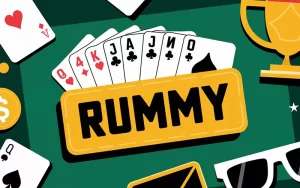Rummy is a popular card game known for its fun and strategic gameplay. Whether you are playing with family or friends, understanding rummy rules, rummy card rules, and rummy card game rules is essential for enjoying this game. In this guide, we’ll explain everything you need to know about the rules of rummy, how to play the game, and the key terms used. So, if you want to learn how to play Rummy and have an enjoyable experience, keep reading.
What Are Rummy Rules?
The basic rummy rules are simple to follow, which is one of the reasons why the game has become so popular. The game is typically played with a standard deck of 52 cards. The main goal in Rummy is to form sets and runs by drawing and discarding cards, while trying to prevent your opponents from doing the same.
The Object of the Game

The primary objective in rummy card game rules is to form a valid hand by grouping cards in two ways:
- Sets: Three or four cards of the same rank (e.g., 7♠, 7♣, 7♥).
- Runs: Three or more consecutive cards of the same suit (e.g., 4♦, 5♦, 6♦).
Once a player successfully forms these combinations, they can “declare” and win the game.
Understanding the Rummy Card Rules: Turns and Actions
Now that you know the basics of rummy card game rules, let’s take a closer look at the actions you can take during your turn.
Drawing Cards
- Stockpile: You can draw a card from the stockpile (the deck of remaining cards placed face-down).
- Discard Pile: You can also draw the top card from the discard pile (cards discarded by other players).
Forming Sets and Runs
Once you have drawn your card, you can begin forming sets and runs. You can add cards to your existing sets and runs, or try to form new ones.
Discarding
After drawing, the player must discard one card from their hand to the discard pile. This is an essential part of the game, as you must always end your turn with exactly one card discarded.
Declaring the Winner
A player can “declare” and win the game when they have formed valid sets and runs with all their cards. This means they can lay down all their cards and show their combinations.
Ending the Round
The round ends when a player declares and wins, or when the stockpile runs out. If the stockpile is empty, the game is considered a draw, and no one wins the round.
Rummy Card Rules: Key Terms You Should Know
In order to fully understand the rummy card rules, there are a few important terms to be familiar with.
- Meld: A valid set or run of cards.
- Joker: A wild card that can be used to replace any card in a set or run.
- Gin Rummy: A version of Rummy where a player must have all their cards in valid sets and runs before declaring.
- Knocking: A player can knock if their unmatched cards are below a certain point value, signaling they are ready to end the round.
Rummy Card Game Rules: Scoring
While Rummy is mainly about strategy and fun, scoring adds an extra element of competition. The score is calculated based on the cards left in each player’s hand when someone wins the round.
Types of Rummy and Their Rules
There are several versions of Rummy, and each has slightly different rules. Below are some of the most popular variations:
- Gin Rummy: Played between two players. A player must have all their cards in sets or runs to declare.
- Indian Rummy: Played with two decks of cards, and the game involves forming at least two sequences (one of which must be a pure sequence).
- Oklahoma Rummy: A variation where the first card dealt determines the number of points required to win the game.
- Kalooki Rummy: Similar to Indian Rummy, but players can use two jokers in their combinations.
Conclusion
Understanding rummy rules, rummy card rules, and rummy card game rules is key to becoming a skilled player. The game may appear simple at first, but it requires strategy, observation, and practice. By learning the rules, practicing the gameplay, and avoiding common mistakes, you can improve your skills and enjoy playing Rummy with friends and family.







